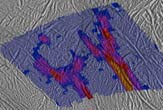Saturn Moon's 'Tiger Stripes' More Extensive Than Thought

The web of warm fissures feeding the ice geysers on Saturn's moon Enceladus is more extensive and intricate than scientists had imagined, images from NASA's Cassini probe show.
The unmanned Cassini spacecraft discovered several additional cracks in the surface of Enceladus' south pole during an Aug. 13 flyby of the moon. The probe's observations have allowed scientists to construct the most detailed heat maps of the region to date, researchers said. [New heat map of Saturn moon Enceladus]
Cassini revisited Enceladus this week with a Tuesday (Nov. 30) flyby. The spacecraft flew within 30 miles (48 kilometers) of the icy moon's northern hemisphere. The warm cracks from the new study, however, were found during Cassini's pass over Enceladus' southern half.
Though Enceladus' surface is frosty, heat wells up through its huge south pole fissures, which planetary scientists have named "tiger stripes." This heat provides energy for the moon's famed icy jets, which spew water vapor and organic particles into space.
The newly observed cracks appear to branch off from the ends of other tiger stripes, according to researchers.
"The ends of the tiger stripes may be the places where the activity is just getting started, or is winding down, so the complex patterns of heat we see there may give us clues to the life cycle of tiger stripes," John Spencer, a Cassini scientist based at Southwest Research Institute in Boulder, Colo., said in a statement.
Massive heat exchange
Sign up for the Live Science daily newsletter now
Get the world’s most fascinating discoveries delivered straight to your inbox.
Cassini first discovered the ice geysers of Enceladus — Saturn's sixth-largest moon — in 2005. The spacecraft has made many flybys of Enceladus — the August encounter was the probe's 11th — helping scientists piece together what drives the otherworldly geysers.
Researchers now know that Enceladus, once thought to be cold and geologically dead, has a complex heat-circulation system. This system draws warmth up from the moon's subsurface — perhaps via a bubbly ocean of liquid water — and channels it to the jets through the tiger stripes.
Massive amounts of heat are flowing through Enceladus' south pole — about five times more heat per unit area than flows through Earth's geologic hot spot, Yellowstone National Park, scientists have said.
The new images and heat maps, from Cassini's Aug. 13, 2010, Enceladus flyby, should help scientists flesh out this heat exchange more fully, researchers said.
Eyeing the tiger stripes
Cassini used its infrared spectrometer and high-resolution camera to study Enceladus' south pole.
The probe examined the hottest part of the tiger stripe system, part of the fracture called Damascus Sulcus. On Enceladus, the spacecraft observed temperatures in Damascus up to minus 120 degrees Fahrenheit (minus 84 degrees Celsius). While that sounds cold, it is actually quite warm for this icy moon around Saturn.
This is slightly higher than previously measured temperatures at Damascus, which were around minus 150 degrees Fahrenheit (minus 101 Celsius) — a difference with several possible causes, scientists said.
One explanation may be that the tiger stripe is just more active than it was the last time Cassini observed it in 2008, researchers said. Or the hottest part of the tiger stripe may be so narrow that previous scans averaged its temperature out over a larger area.
In any case, the new observations had such a high resolution — revealing details as small as 2,600 feet (800 meters) — that scientists could see warm material flanking the central trench of Damascus for the first time, researchers said. [Best Cassini Images of Saturn]
The Damascus thermal scan also shows large variations in heat output within a few kilometers along the length of the fracture. This unprecedented resolution will help scientists understand how the tiger stripes deliver heat to the surface of Enceladus, scientists said.
Cassini's last sunlit southern look
Cassini recorded the thermal map of Damascus simultaneously with a visible-light image where the tiger stripe is lit by sunlight reflecting off Saturn. The visible-light and thermal data were merged to help scientists understand the relationships between physical heat processes and surface geology.
"Our high-resolution images show that this section of Damascus Sulcus is among the most structurally complex and tectonically dynamic of the tiger stripes," team member Paul Helfenstein of Cornell University said.
The Aug. 13 encounter was Cassini's last remote-sensing flyby of the moon until 2015. The geometry of the many flybys between now and 2015 — such as Tuesday's pass — will not allow Cassini to do other similar thermal scans; the spacecraft will be too close to the surface, and it will not view the south pole.
This Enceladus flyby also gave Cassini its last look at the active south polar region in sunlight, researchers said.
- Gallery: Cassini's Latest Discoveries
- Video: Surprising Geyser in Space: Cold Faithful on Enceladus
- Eau! 'Perrier Ocean' Could Give the Kick to Saturn Moon's Geysers
This article was provided by SPACE.com, a sister site of LiveScience.com.











